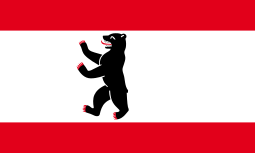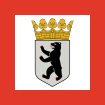
Back Сцяг Берліна Byelorussian Bandera de Berlín Catalan Flagge Berlins German Σημαία του Βερολίνου Greek Bandera de Berlín Spanish پرچم برلین Persian Drapeau de Berlin French דגל ברלין HE Vlag van Berlijn Dutch Berlins flagg NB
 | |
| Landesflagge (state flag) | |
| Use | Civil flag and ensign |
|---|---|
| Proportion | 3:5 |
| Adopted | 26 May 1954 |
| Design | A tricolor of red-white-red, defaced with an emblem. |
| Landesdienstflagge (state service flag) | |
 | |
| Use | State flag and ensign |
| Proportion | 3:5 |
| Adopted | 1954 (West); 1990 (Whole) |
| Standard of the Berlin Senate | |
 | |
| Use | State flag |
| Proportion | 1:1 |
| Adopted | 1990 |
The state flag of Berlin, Germany has three stripes of red-white-red, the two outer stripes each occupying a fifth of its height, the middle the remaining three-fifths. It is emblazoned with a bear on the civil flag, while it bears the coat of arms of Berlin on the state flag.
The civil flag of West Berlin was adopted on 26 May 1954. Designed by Ottfried Neubecker, it came in second in the 1952 contest, the winner having been rejected by the Senate. The bear is placed slightly off-center toward the left.
A bear could be found on seals, coins, and signet rings from as early as the late 12th century (but not as a heraldic charge before 1709), presumably due to a canting association with the city's name.[1]
The state flag replaces the bear with the full coat of arms, with the bear inside the escutcheon. Being the state flag for West Berlin, it became the flag of the entire city after the reunification of Germany in 1990.[2] Prior to that, it had also been the naval ensign, as no other existing flag could be used. The proportions of the flag are 3:5.[3] However, it was only used until 2007 when the Abgeordnetenhaus passed a bill to abolish the state flag. Since then, Berlin has had only one official flag.
- ^ Konrad Berlin, "Berliner Bär und Mäuseturm", Muttersprache 1958, pp. 271-273. The name Berlin is of Slavic origin and unrelated to the word bear, but the area was settled by German speakers from as early as the 12th century. Reinhard E. Fischer: Die Ortsnamen der Länder Brandenburg und Berlin. Alter – Herkunft – Bedeutung. be.bra wissenschaft verlag, Berlin-Brandenburg 2005, ISBN 3-937233-30-X, S. 25.
- ^ Birgit Laitenberger; Maria Bassier (2000), Wappen und Flaggen der Bundesrepublik Deutschland und ihrer Länder: Allgemeine Einführung (Coats-of-arms and flags of the Federal Republic of Germany and her states: General introduction in state symbols) (in German)
- ^ State Chancellery (1954), Gesetz über die Hoheitszeichen des Landes Berlin vom 13. Mai 1954 (Law on the State Symbols of the State of Berlin of 13th May 1954) (in German)
© MMXXIII Rich X Search. We shall prevail. All rights reserved. Rich X Search